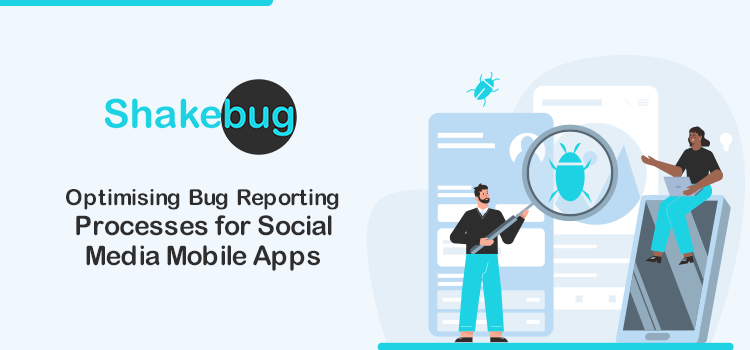Optimising bug reporting processes for social media mobile apps is a critical initiative for developers today.
With billions of users accessing social media platforms primarily via mobile devices, effective bug-reporting mechanisms can significantly improve the user experience.
By optimising social media mobile app bug reporting, developers can address issues ahead of time, improve app ratings, and increase user retention.
This article will discuss specific techniques and best practices to improve the bug-reporting process for social media mobile apps.
Types of Bugs in Social Media Mobile Apps
A. User interface (UI) bugs impacting navigation and usability
User interface (UI) bugs in social media mobile apps are issues with the app’s visual presentation and interactive elements. These types of bugs impair the user’s ability to navigate and use the various features efficiently.
Some common UI bugs include alignment issues, which occur when elements on the screen are not properly centred or spaced out.
This can give the app a disjointed appearance and make it frustrating to use. Other UI bugs include responsiveness issues, which occur when a user taps or swipes on the screen but the app does not react as expected.
This results in a poor user experience. Additional UI bugs occur when graphical elements are distorted or do not render properly.
B. Performance issues affecting loading times and responsiveness
Performance issues are common bugs that afflict social media mobile apps and frustrate users. These bugs are caused by suboptimal code that strains phone resources, depletes battery life, and causes apps to crash or freeze.
One common performance issue is slow load times, which occur when pages and images take too long to appear after being tapped on. This sluggishness makes the app feel clunky and unresponsive.
Another annoyance is choppy scrolling, in which the feed or pages judder rather than scroll smoothly. This jittery motion could be more appealing and make the app appear unpolished.
Excessive battery drain from inefficient background processes is also problematic, as it reduces battery life and irritates users. App crashes, particularly those caused by memory leaks, are also disruptive.
C. Security vulnerabilities posing risks to user data and privacy
Social media mobile apps have several bugs and security flaws that can jeopardise user data and experience. Cross-site scripting is a common issue in which malicious code is injected into the app to steal session cookies or sensitive data. This gives hackers the ability to take over user accounts or gain access to private messages and photos.
Another vulnerability is poor data transmission and storage encryption, which allows for the interception of login credentials or private conversations.
Outdated software libraries with known exploits can also be problematic if not updated on time. Insufficient input validation can lead to SQL injection attacks and buffer overflows.
Weak default credentials for cloud services associated with the app are also inviting targets.
The Significance of Timely Bug Reporting
Timely bug reporting is critical for streamlining bug-reporting processes in social media mobile apps. When users encounter bugs or issues in an app, they should be able to easily report them so that developers can address them as soon as possible.
The faster bugs are reported, the quicker they can be fixed in-app updates. This enhances the overall user experience and keeps bugs from negatively impacting more users over time.
However, many social media apps lack simple bug-reporting options within the app interface. Users must submit bug reports through external sites or support centres, which adds steps and makes reporting bugs inconvenient.
This slows the rate at which bugs are reported because users are less likely to spend time submitting detailed reports externally.
The quicker users can submit quality bug reports directly in the app, the faster developers can replicate, prioritize, and resolve issues.
This creates a positive cycle in which apps continue to improve as a result of rapid user feedback. Overall, seamless and timely in-app bug reporting is essential for social media apps to provide optimal user experiences and quickly resolve bugs that arise.
Designing User-Friendly Bug Reporting Interfaces
Optimizing bug reporting processes for social media mobile apps requires developing user-friendly interfaces that allow users to submit detailed, actionable bug reports.
The goal is to collect high-quality feedback from users so that developers can efficiently reproduce and resolve issues.
An effective bug-reporting interface should have a clear access point within the app, such as a “Report Bug” button in the settings menu.
It should prompt users to describe the problem in detail, including steps to reproduce, expected vs. actual behaviour, screenshots, device model, app version, and any other relevant information. Dropdown menus, input fields, and attachment options can help users provide this information.
The interface should be simple and mobile-friendly, without complicated menus or small text. Clear guidance, input validation, and smart auto-fill features all contribute to higher submission quality. Confirmation messages and bug status tracking enhance the user experience.
Overall, an optimized bug-reporting process begins with an interface that is specifically designed to collect actionable information from users while providing a streamlined mobile experience. This enables developers to quickly resolve issues, resulting in higher app quality and user satisfaction.
Implementing Automated Bug Tracking Systems
Implementing automated bug-tracking systems can significantly improve the efficiency and effectiveness of finding and fixing bugs.
When users encounter problems in a mobile app, they require an easy way to report them to developers. However, sorting through user complaints on app store reviews or social media can be difficult for developers.
Automated bug tracking systems enable users to submit bug reports directly within the app, which are then stored in a central repository for developers to review and resolve.
These systems automatically collect key data such as device specifications, software versions, and reproduction steps to assist developers in replicating and pinpointing bugs more quickly.
Some systems even use artificial intelligence to automatically categorize reports based on priority level or bug type to streamline triage.
These systems automatically collect key data such as device specifications, software versions, and reproduction steps to assist developers in replicating and pinpointing bugs more quickly.
Some systems even use artificial intelligence to automatically categorize reports based on priority level or bug type to streamline triage. Developers can then receive automatic notifications of new high-priority bugs that require immediate investigation.
Engaging Users in the Bug Reporting Process
To optimize bug reporting processes for social media mobile apps, effective user engagement is required. Simply providing a generic form for reporting bugs often results in low participation and vague, unhelpful reports.
Instead, apps should guide users through the reporting process, prompting them for details such as reproduction steps, affected features, screenshots, device information, and so on.
A perfect mobile app bug reporting tool should streamline this process, ensuring users can easily submit detailed, structured reports that help developers diagnose and resolve issues quickly.
Feedback mechanisms such as upvoting existing reports assist in prioritizing the most important bugs. Achievement badges and contributor leaderboards are gamification elements that make the process more rewarding.
Communicating Bug Fixes and Updates
When bugs are discovered, there must be clear channels for users to directly report them to the engineering team.
Bugs should be prioritized after they have been logged based on their severity, prevalence, and ease of fixing. The engineering team needs an efficient triage process to validate bugs and schedule them for future releases.
The next important step is to communicate bug fixes and updates to users. Release notes in app stores are useful but insufficient. Push notifications to devices should highlight important bug fixes and new features.
Social media platforms can also highlight resolved issues and respond to user complaints. Personalized emails after bug fixes can make frequent users feel valued.
Smooth communication about bugs promotes user retention, increases customer satisfaction, and protects brand reputation.
Companies can optimize the cycle from bug reporting to resolution by implementing proper processes that align engineering with user needs.
Overcoming Challenges in Bug Reporting
The bug reporting in mobile apps and social media platforms can be challenging for both users and developers. Today’s apps have complex codebases, and platforms must scale to millions of users, making it difficult to reproduce and debug every issue.
Users are frustrated when their bug reports go unanswered, and developers are overwhelmed by duplicate or ambiguous reports that are difficult to act on.
To improve this process, businesses are optimizing their bug-tracking workflows to make reporting bugs easier while capturing all of the information developers require to squash them.
Some best practices include in-app reporting flows with customized forms for gathering device specs, screenshots, recreation steps, and other relevant information.
Saving these details on the backend allows developers to easily reproduce bugs. Data mining techniques can also group duplicate reports.
Providing feedback to users demonstrates that their issue has been received, and public bug trackers promote transparency. Users feel heard when workflows are optimized, developers can prioritize and fix bugs more quickly, and products improve.
The challenge is to create systems that are both user-friendly and robust. Striking that balance results in effective bug-reporting processes in which users play an active role in improving their favourite apps and social platforms.
Conclusion
In conclusion, optimizing bug reporting processes for social media mobile apps is critical to providing users with the best possible experience.
Social media companies should implement efficient systems that allow users to submit detailed and organized bug reports. This could include in-app forms with guided sections and the option to attach screenshots or videos.
Companies should form teams to review and prioritize bug reports, track them in ticketing systems, and communicate progress to users.
Reproducible steps should be required to validate bugs before allocating development resources. Automated crash reporting tools can also be useful in gathering diagnostic data on bugs.
Overall, social media companies that take bug reporting seriously and continuously improve their processes will experience higher user satisfaction, retention, and engagement.
Companies can increase loyalty and improve their apps by making it easy for users to submit actionable bug reports and feel heard.
A thoughtful bug reporting system demonstrates a commitment to users and emphasizes the value of community feedback in creating better digital experiences.


